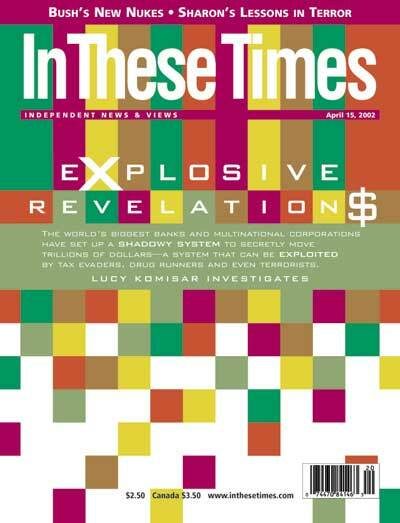
Tsai Ming-liang, the Taiwanese director of a decades worth of urban hilarityall of it bone-dry and gorgeous in structure, not to mention achingly saddeserves better than praise. He deserves to be seen. I say blame the messenger: Tsai invites the most flattering of comparisons from grizzled posses of critics bent on running down the next severe master à la Antonioni and Ozu. Yes, Tsai is all that, but know too that hes funnier and far less intimidating. Urgently, he needs to be saved from his flat-footed penpals, and who better to do that than audiences?
What Time Is It There? is Tsais fifth feature and perhaps the best place to begin a beautiful friendship. (No, its not a sellout; if anything, Tsai has further refined his minimalist tendencies, trimming dialogue and motion to a purists pinprick.) The story concerns two young people, one in bustling Taipei, the other abroad in unfamiliar Paris. While never linked romantically (they only meet twice, and briefly at that), they wander through a shared haze of intercontinental longing, spun by Tsai like an ingenious clockwork of weird habits and desperate expressions. Think of it as the anti-Amélie, without that movies hypercute aggression, and told with a far richer reserve.
Love equals loneliness in the Tsai universe, and I suspect this will strike a chord with even the pixie-haired sprites of the world. With each film, he presents a different obstacle to human attachment, often disguised as the very opening for those feelings in the first place. In Vive LAmour it was a vacant apartment, host to rotating squatters, home to none. In The Hole, undoubtedly the sweetest musical about plague to date, Tsai links two strangers via a bizarre puncture in the floor. (Or the ceiling, depending on your perspective.)
Now the fissure is timezones, in all their arbitrary fixity, but also the temporal divide between the living and the dead. What Time Is It There? springs off from a family about to be derailed by grief; in its first uninterrupted moments, we see the old man (Miao Tien), smoking in his tiny quarters, an uneaten plate of food before him. He gets up to move a potted plant. He sits down again. He broods.
In a cut, hes gonenow presumably the contents of the funeral urn being transported by taxi to a final resting place. What follows can safely be called a ghost story, but notice Tsais marvelous economy in just that opening shot. For all his ordinariness, the father burns into our memory and stays there, as he does on the haunted brow of his son, played by Tsai regular Lee Kang-sheng. Lee, with his bee-stung lips and bruised gaze, is one of those rare gifts to directors jonesing for transparency. Hes often been compared to James Dean, but hes more like an ideal union of Dean with Sal Mineo, his curious tag-along from Rebel Without a Cause: the swoon coupled with a gawky sense of ruffled oddity. You cant take your eyes off him.
Lee makes a lackadaisical living selling watches as street vendor. Instantly, one feels protective for him when a slightly pushy young woman (Chen Shiang-chyi, another outstanding Tsai find) fixes on his own wristwatch with a covetous squint. Demurring, he tells her its bad luck, that hes in mourning, but shes not having any of it. She needs his dual-time mechanism for a trip to Paris. Eventually, she gets her way, but not without dropping on him more than cash and her gratitude; he cant seem to let go of her memory. Buried under his bedsheets, Lee dials the phone operator in the middle of the night and asks the films title question. A muted amour fou is born.
If Tsai were a lesser artist, he might rate some of the well-intentioned term papers coming from fustier reviewers: Existential Alienation, ahoy! But fortunately, hes too damn entertaining for that. Obsessions suit Tsai to a T (he has a thing for dripping water) and immediately, he devotes himself to establishing a living presence of all the ticking clocks in the vicinity. Lee starts by purposefully resetting every timepiece in his case to seven hours earlier, the full ashtray by his side speaking volumes to a strange mania. Soon, he secretly turns back the kitchen clock (his mother interprets this, touchingly, as the return of her husbands spirit, leading to some unorthodox dinner times), and even the huge hour-hand on a large buildings facade becomes fair game.
Why does he do this? Passion, perhapsor maybe its just his way of mourning. In either case, Tsai never comes out and says so, and the modesty feels right; such are the mysterious impulses people feel when theyre hurting. Tsais patience is oddly catching as he floods the frame with minute invaders given their proper due: a pigeon strolls leisurely across the widescreen, a white carp cruises in its fishtank. (The serene photography is by Benoît Delhomme.) Such pictorial sensibilities are rare these gabby days, leading many to praise Tsai as a rediscoverer of silent-era potency. But while he certainly merits this, it only speaks to half his skill as a storyteller who builds from implicit solitudes: On a rooftop, Lee uncorks a bottle of red wine, pours a glass and stares westward.
Over the horizon, there is a Paris tale being woven in, featuring the watch-buyer, her assertiveness long dissolved into a kindred isolation. Chen drifts through cafés and metro platforms, a stranger in self-imposed exile. Why did she ever come so far to be so blue? Again, Tsai leaves motives unspoken, instead courting the off-kilter charms of more abstract connections. Lee basks sullenly in the cathode glow of Truffauts The 400 Blows, channeling the nighttime prowlings of a young Jean-Pierre Léaud gulping from a stolen jug of milk; Chen, meanwhile, has an actual encounter with the grown-up star on a Parisian cemetery bench. (Léaud, looking supremely Gallic in his leather coat and insouciance, hits on her.) Finally, the sweetest kind of movie reference: one that makes sense without a cinema studies degreean expression of unquenched thirsts, ready for the tapping.
Throughout, Tsai makes his rhymes work with an almost subliminal grace: from him to her, from clocks to hearts, from an ancient Paris graveyard to the modern passageways of locker-like columbaria, where Buddhist rites are performed over ashes. With understated rigor, What Time Is It There? eventually synchronizes its loners and themes to such a degree that the result is close to spiritual. Clocks are circular, as is the final image of Tsais coda, a ferris wheel, and were left with the hopeful intimation of release, maybe even rebirth. Its a perfect picture of nirvana, one that stays in the mind for days. To intellectualize it further would be a crime. Try this oneI promise it wont bite.
What Time Is It There? is Tsais fifth feature and perhaps the best place to begin a beautiful friendship. (No, its not a sellout; if anything, Tsai has further refined his minimalist tendencies, trimming dialogue and motion to a purists pinprick.) The story concerns two young people, one in bustling Taipei, the other abroad in unfamiliar Paris. While never linked romantically (they only meet twice, and briefly at that), they wander through a shared haze of intercontinental longing, spun by Tsai like an ingenious clockwork of weird habits and desperate expressions. Think of it as the anti-Amélie, without that movies hypercute aggression, and told with a far richer reserve.
Love equals loneliness in the Tsai universe, and I suspect this will strike a chord with even the pixie-haired sprites of the world. With each film, he presents a different obstacle to human attachment, often disguised as the very opening for those feelings in the first place. In Vive LAmour it was a vacant apartment, host to rotating squatters, home to none. In The Hole, undoubtedly the sweetest musical about plague to date, Tsai links two strangers via a bizarre puncture in the floor. (Or the ceiling, depending on your perspective.)
Now the fissure is timezones, in all their arbitrary fixity, but also the temporal divide between the living and the dead. What Time Is It There? springs off from a family about to be derailed by grief; in its first uninterrupted moments, we see the old man (Miao Tien), smoking in his tiny quarters, an uneaten plate of food before him. He gets up to move a potted plant. He sits down again. He broods.
In a cut, hes gonenow presumably the contents of the funeral urn being transported by taxi to a final resting place. What follows can safely be called a ghost story, but notice Tsais marvelous economy in just that opening shot. For all his ordinariness, the father burns into our memory and stays there, as he does on the haunted brow of his son, played by Tsai regular Lee Kang-sheng. Lee, with his bee-stung lips and bruised gaze, is one of those rare gifts to directors jonesing for transparency. Hes often been compared to James Dean, but hes more like an ideal union of Dean with Sal Mineo, his curious tag-along from Rebel Without a Cause: the swoon coupled with a gawky sense of ruffled oddity. You cant take your eyes off him.
Lee makes a lackadaisical living selling watches as street vendor. Instantly, one feels protective for him when a slightly pushy young woman (Chen Shiang-chyi, another outstanding Tsai find) fixes on his own wristwatch with a covetous squint. Demurring, he tells her its bad luck, that hes in mourning, but shes not having any of it. She needs his dual-time mechanism for a trip to Paris. Eventually, she gets her way, but not without dropping on him more than cash and her gratitude; he cant seem to let go of her memory. Buried under his bedsheets, Lee dials the phone operator in the middle of the night and asks the films title question. A muted amour fou is born.
If Tsai were a lesser artist, he might rate some of the well-intentioned term papers coming from fustier reviewers: Existential Alienation, ahoy! But fortunately, hes too damn entertaining for that. Obsessions suit Tsai to a T (he has a thing for dripping water) and immediately, he devotes himself to establishing a living presence of all the ticking clocks in the vicinity. Lee starts by purposefully resetting every timepiece in his case to seven hours earlier, the full ashtray by his side speaking volumes to a strange mania. Soon, he secretly turns back the kitchen clock (his mother interprets this, touchingly, as the return of her husbands spirit, leading to some unorthodox dinner times), and even the huge hour-hand on a large buildings facade becomes fair game.
Why does he do this? Passion, perhapsor maybe its just his way of mourning. In either case, Tsai never comes out and says so, and the modesty feels right; such are the mysterious impulses people feel when theyre hurting. Tsais patience is oddly catching as he floods the frame with minute invaders given their proper due: a pigeon strolls leisurely across the widescreen, a white carp cruises in its fishtank. (The serene photography is by Benoît Delhomme.) Such pictorial sensibilities are rare these gabby days, leading many to praise Tsai as a rediscoverer of silent-era potency. But while he certainly merits this, it only speaks to half his skill as a storyteller who builds from implicit solitudes: On a rooftop, Lee uncorks a bottle of red wine, pours a glass and stares westward.
Over the horizon, there is a Paris tale being woven in, featuring the watch-buyer, her assertiveness long dissolved into a kindred isolation. Chen drifts through cafés and metro platforms, a stranger in self-imposed exile. Why did she ever come so far to be so blue? Again, Tsai leaves motives unspoken, instead courting the off-kilter charms of more abstract connections. Lee basks sullenly in the cathode glow of Truffauts The 400 Blows, channeling the nighttime prowlings of a young Jean-Pierre Léaud gulping from a stolen jug of milk; Chen, meanwhile, has an actual encounter with the grown-up star on a Parisian cemetery bench. (Léaud, looking supremely Gallic in his leather coat and insouciance, hits on her.) Finally, the sweetest kind of movie reference: one that makes sense without a cinema studies degreean expression of unquenched thirsts, ready for the tapping.
Throughout, Tsai makes his rhymes work with an almost subliminal grace: from him to her, from clocks to hearts, from an ancient Paris graveyard to the modern passageways of locker-like columbaria, where Buddhist rites are performed over ashes. With understated rigor, What Time Is It There? eventually synchronizes its loners and themes to such a degree that the result is close to spiritual. Clocks are circular, as is the final image of Tsais coda, a ferris wheel, and were left with the hopeful intimation of release, maybe even rebirth. Its a perfect picture of nirvana, one that stays in the mind for days. To intellectualize it further would be a crime. Try this oneI promise it wont bite.
Joshua Rothkopf has been covering cinema for In These Times since 1999. His work has appeared in The Village Voice, The Chicago Reader, Isthmus and City Pages, among other publications.







